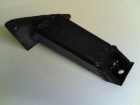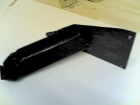Engine Swap - M6x
Not much compares to a V8. The thunderous roar, the pulsing of power at idle and all that wonderful, wonderful torque make a V8 an engine swap wet dream for many, which is why BMW fitted their M6x family of V8s into the bigger cars.
Fitting the eight-cylinder magnificence in an E30 engine bay is therefore a winning combination, and the engine swap of true heroes. But it's not to be taken lightly. But if you're up to the challenge, here's how to fit a monster 4.0 litre V8 M6x engine into your E30.
Contents
Overview
Taking on this challenge requires some serious guts, cash and lateral thinking. Before you buy a single bolt, bear in mind that the E30 pre-dates all BMW V8 engines; the earliest V8 is 1992. Therefore, some significant customisation will be required to squeeze the prodigious bulk of the M6x into the engine bay. The plus side of this is that any E30 can be used as a starting project, since none of the original components will be suited to the task anyway. Our favourite is to use a chrome pre-facelift shell, complete with the 316 badge on the boot lid, just for giggles.
The V8 comes in two distinct flavours; M60 and M62, with sizes ranging from 3.0 to 4.6 litres. They are almost identical in size, but the power output differs considerably; the 3.0's 215bhp seems almost anaemic compared to the 282hp of the larger 4.0 litre M60 unit. The M62 has similarly varying outputs, with the largest M62 kicking out an eye-watering 342hp - if you want any more than that, you're entering S62 territory.
Considering the complexity of the build, it's only worth doing if you use one of the bigger engines; either the M60B40, M62B44 or M62B46.
With that in mind, most of the running gear will involve replacing to cope with the dramatically increased power. Besides the engine, you'll also need to source a gearbox and clutch, propshaft and differential to get the power to the back wheels. Custom mounts will need to be sourced or built to hold it all together. Around the engine, changes need to be made to the radiator system, and the brake servo will need to be moved or replaced to accommodate the engine. You'll also need to find an exhaust solution. Another guarantee is the brakes; they will need to be substantially upgraded to cope, otherwise you'll crash at the first corner.
For a more comprehensive list, check out the parts list.
Parts List
The parts list is both lengthy and comprehensive. Click each part for more info.
- Full M6x Engine with all ancillaries (injectors, MAF, inlet, coil packs, alternator)
- Engine mounts
- Complete engine loom
- Gearbox
- Clutch
- Propshaft
- Differential
- Exhaust including manifolds
- Fan
- Radiator
- Universal Joint
- Gear bridge
- Brake servo
Engine
There's no point in doing this swap if you're not going to use a big V8. Both the 3.0 litre M60 and 3.5 litre M62, while grunty, will not justify the hundreds of hours and thousands of pounds that this swap entails - even if the engine is free.
Whether M60 or M62, all engines use an alloy block and head. After 1998, the M62 engines were fitted with VANOS. The engine options are:
- M60B40 - fitted to the E31, E32, E34 and E38
- M62B44 - fitted to the E38 and E39
- M62B46 - fitted to the E38, E39 and E53
All engines install in the same manner; however, the later M62 engines will be fitted with EWS. This means you need the correct key and receiver for the car, or have the EWS disabled somehow.
Mounts
Because of the size, it's essential to get the M6x engine properly placed. This isn't just a matter of squeezing it into the available space, but also to ensure that it's not so far forward that it upsets the handling of the car.
To solve this, you can either buy custom mounts, or make your own. If making them yourself, you need to comprehend BMW's bizarre decision to pass the remote oil filter plumbing through the left-hand mount. Because of this, we recommend keeping the original mount fitted to that side, and simply fabricating an extender to mate the original to the rubber bush on your chassis rail.
To help you keep things lined up, the distance between the engine mount centres measured across the subframe is 610mm exactly.
Gearbox
There are three gearboxes to choose from; either a 5- or 6-speed manual gearbox, or an automatic. There choice is entirely up to you, but what you buy will directly affect which differential you use. To explain; the auto box on an E32 730i V8 is a 5 speed, the A5S310Z with the 0.74 overdrive fifth. In comparison, a five speed manual V8 box has a direct drive non overdrive fifth so you'll need a nice tall diff to cope - a 3.25 M3 diff will be ideal. The six speed units on the 540i and 840i used the same ratios but with an overdrive sixth.
The 5-speed box can be found in t
Unfortunately, gearboxes from V12 engines do not fit; they have the wrong bolt pattern for the V8 engine.
Differential
This needs to be chosen to match your gearbox.
Cooling
Radiator
Exhaust
Manifold
Being a V8, you'll need two manifolds - one to cope with each head. This doubles the complexity of the task, since both need modification to fit.
The left-hand manifold (passenger side for UK cars) is the simpler of the two, since there's not much else on that side of the car to interfere. In this case, the existing manifold only needs a bit of chopping and welding to fit, as in this picture:
Brakes
Because of the sheer enormity of the M6x engines, you have next to no chance of retaining the brake servo in its standard place. You therefore have two options.
- Relocate the entire mechanism to the other side of the passenger inner wing, so that it sits behind the headlight.
- Remove the glovebox and fit the servo inside the cabin, keeping the master cylinder inside the engine bay.





